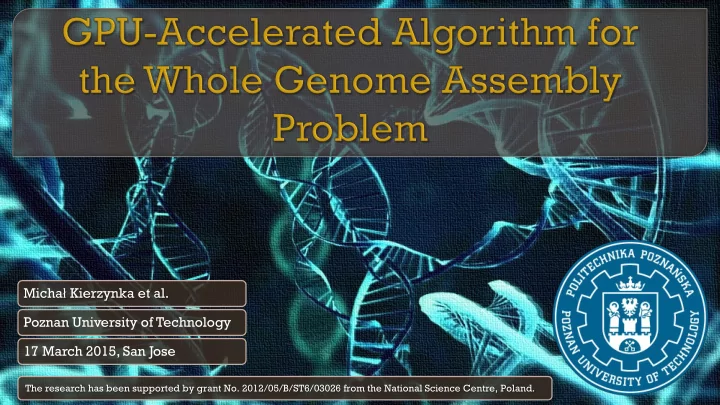

Micha ł Kierzynka et al. Poznan University of Technology 17 March 2015, San Jose The research has been supported by grant No. 2012/05/B/ST6/03026 from the National Science Centre, Poland.
DNA de novo assembly input: short reads (35-150bp) output: contigs (assembled parts of a genome) TTAGCACAGGAACTCTA Illumina Genome TTTGC-C GA-CTC Analyzer II sequencer AGCA TTCTA ATCA-AGCAAC AGCA ATCAAGCAAC GACTC TAGAA TTTGCC
DNA de novo assembly Input sequences: a multiset of overlapping reads over alphabet {A, C, G, T} may contain misreadings/errors come from both strands of the DNA double helix reverse complement sequences Problems: large data sets: millions of reads (e.g. ~300GB for homo sapiens ) exact algorithms are exponential quality of heuristics is often limited
DNA de novo assembly DNA overlap graph: each read represented by a vertex overlapping sequences connected by an arc weights, e.g. corresponding alignment scores result: a Hamiltonian path for each connected component Selection of overlapping sequences!
DNA overlap graph construction Selection of overlapping sequences: not feasible to compare every sequence with each other O(n 2 ) promising pairs - pairs of sequences that are likely to overlap fast preselection of promising pairs overlaps verification (greatly increases precision) ACGGGTA CTGGAGT CTGGAGT GGGTACT TGGAGTCC CTGAACCG score 5, overlap 2 score 6, overlap 1 score 1, overlap 0
DNA overlap graph construction DNA overlap graph: sort sequences in the way that similar sequences are close to each other O(n log n) verify which of the neighbouring sequences are really similar using exact sequence comparison How to sort sequences properly?
DNA overlap graph construction k-mer – a substring of k consecutive nucleotides from a sequence For each sequence the algorithm computes its k-mer characteristic: 1) extracts every possible k-mer (k is fixed) 2) sorts k-mers descending on their frequencies of occurrence GAACGAACTGAA 1) K=3: 2xAAC, ACG, ACT, CGA, CTG, 3xGAA, TGA 2) 3xGAA, 2xAAC, ACG, ACT, CGA, CTG, TGA Finally, sort all the sequences alphabetically according to their characteristics (similar to a dictionary).
DNA overlap graph construction Partial k-mer characteristics: a set of short characteristics computed for each sequence purpose: to detect also the pairs with short overlaps
DNA overlap graph construction Neighborhood verification by sequence alignment: computationally heavy (Needleman-Wunsch) no solution on the market not a database scan alignment of selected pairs only perfect for GPUs TTAGCACAGGAAC-CTA shift=4 CACAG-AACTCTAGG score=9 Ultra fast implementation on GPU!
DNA overlap graph construction NW and dynamic programming (DP): data dependencies: left, upper and diagonal elements are needed 𝐼 𝑗 − 1, 𝑘 − 𝐻 𝑞𝑓𝑜𝑏𝑚𝑢𝑧 𝐼 𝑗, 𝑘 = max 𝐼 𝑗, 𝑘 − 1 − 𝐻 𝑞𝑓𝑜𝑏𝑚𝑢𝑧 𝐼 𝑗 − 1, 𝑘 − 1 + 𝑇𝑁(𝑡 1 𝑗 , 𝑡 2 [𝑘])
DNA overlap graph construction Key GPU optimizations: bitwise compression of sequencing data optimized for nucleotide sequences extremely efficient memory access: coalesced access + data prefetch up to 256 cells computed from a single int fetch compute bound loop unrolling! DP features nested loops 28 kernels with unrolled loops for various sequence lenghts
DNA overlap graph construction the fastest software in its class worldwide up to 89 GCUPS on a single GPU
DNA overlap graph construction high accuracy of graph construction: sensitivity up to 99% precision: ca. 97% pairs with min. overlap of 40% are well detected very good error handling ultra fast reads alignment on GPU makes it possible to check more promising pairs in a reasonable time
Graph traversal custom greegy algorithm visits every node visited nodes – a sequence of consecutive reads (contig) key difficulty – repetitive genome regions a dedicated algorithm detecting branches graph of contigs
Graph traversal Graph of contigs: useful to perform scaffolding
G-DNA - whole genome test
G-DNA - whole genome test very high quality of contigs expressed as percentage of identity superior contig lengths
Conclusios heavy GPU computations help to construct high quality DNA overlap graphs highly accurate graphs + good traversal method = very high quality contigs memory efficient implementation ready for next-generation sequencing / big data
Contact information Micha ł Kierzynka michal.kierzynka@cs.put.poznan.pl http://www.cs.put.poznan.pl/mkierzynka Please complete the Presenter Evaluation sent to you by email or through the GTC Mobile App. Your feedback is important!
Recommend
More recommend